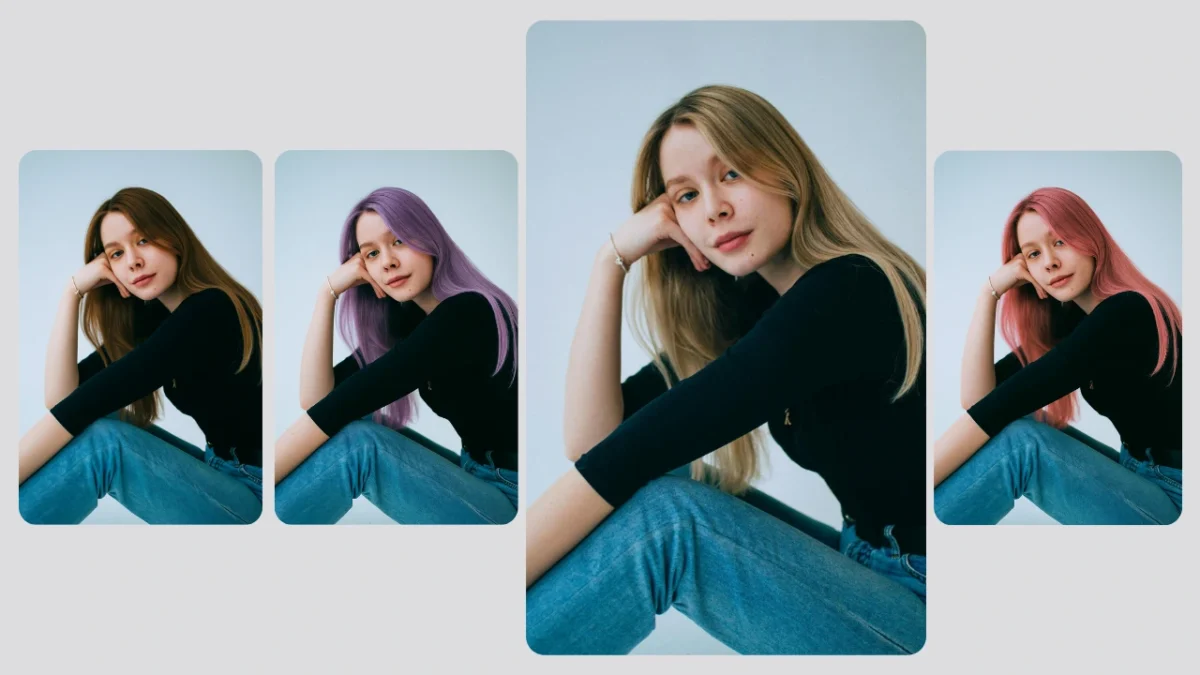1. Changing hair color on models
Virtual hair color try on is the practical, low-risk way to experiment with new shades before making a permanent commitment. Hair color trends shift rapidly—seasonal palettes, celebrity looks, and micro-trends (like root shadows or pastel tones) appear and evolve within months—yet trying these trends in real life can be costly, time consuming, and potentially damaging to hair. Choosing the wrong shade can result in costly salon corrections and weeks or months of regrowth, which is why visual confidence before the dye chair is increasingly important.
We present a clear, actionable guide to virtual hair color try on with modern AI tools, using PiktID’s Create Image as a primary example. You’ll learn how the technology simulates realistic color, how to write prompts that deliver accurate results, and how to integrate virtual trials into personal styling or commercial workflows. We’ll also cover practical benefits—cost savings, faster decision making, and reduced hair damage—as well as common pitfalls and troubleshooting tips to get natural-looking outcomes.
What this post covers:
- A practical definition of virtual hair color try on and core capabilities.
- End-to-end usage: writing prompts, refining results, and exporting assets.
- Best practices for realistic results (lighting, reference images, prompt structure).
- Business use cases for salons, e-commerce, and content creators.
- FAQs and quick troubleshooting.
If you want to experiment immediately, PiktID’s Create Image tool lets you test trend forward shades and styles quickly.
2. What is a Virtual Hair Color Try On Tool?
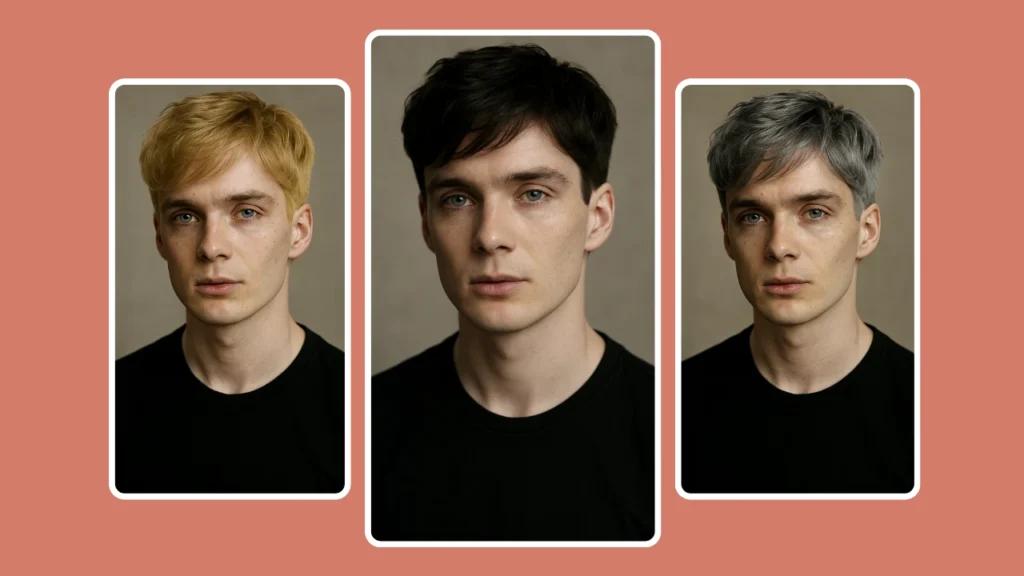
AI hair color changer tool generates realistic previews of hair color changes on a chosen subject. Instead of overlaying flat color, modern tools synthesize hair texture, highlights, shadows, and strand-level variation so the result matches the subject’s lighting, skin tone, and pose. This lets users evaluate how a new color will read in real world conditions—natural light, studio light, or mobile phone lighting—before committing to a salon service.
Key features to expect:
- Realistic shade simulation: multi-tone rendering (base, highlights, lowlights) rather than a single flat color.
- Hair texture awareness: preserves curls, waves, and individual strand behavior so dye appears natural.
- Multiple hairstyle support: test a color across different cuts and lengths without separate photo-shoots.
- Lighting and skin-tone matching: adjusts color saturation and reflectance to stay believable in context.
- Iterative prompts and presets: refine results quickly with modifiers like “root shadow,” “balayage highlights,” or “platinum toner.”
- Export and reuse: download high-res images for client approvals, marketing, or A/B testing.
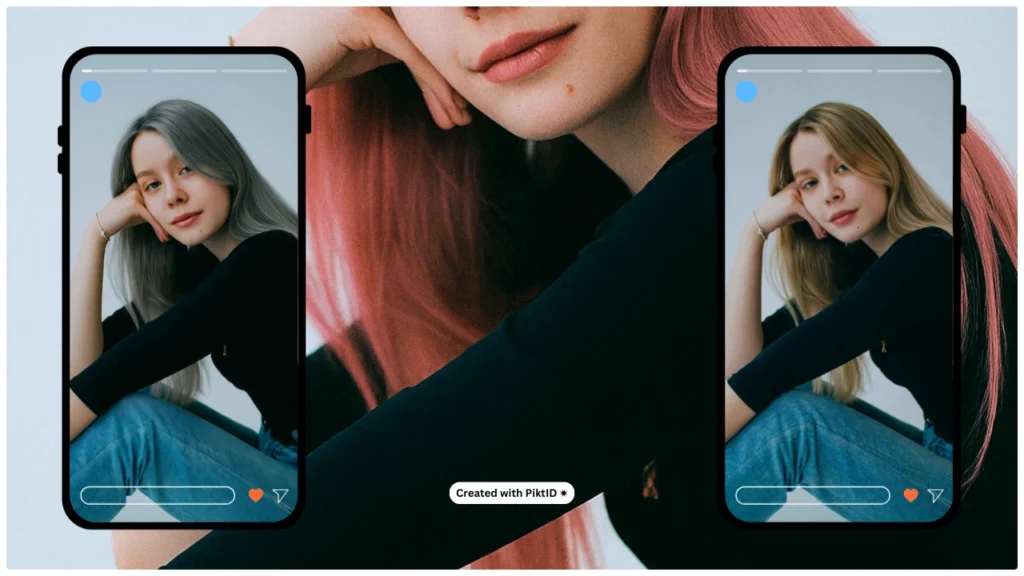
Why it’s trending in 2025:
- Personalization expectations are higher—consumers demand tailored experiences.
- Faster trend cycles require low-friction ways to test looks.
- Sustainability and cost-efficiency: digital trials reduce unnecessary salon visits and product waste.
- Improved AI fidelity: newer generative models produce hair-level detail that was previously unattainable.
PiktID’s Create Image is an example of a virtual hair color try-on workflow that combines prompt-driven generation with advanced controls for realistic, campaign-ready outputs.
PiktID offers more than hair color, read more about AI Haircut.
3. Why Choose PiktID’s Virtual Hair Color Try On?

PiktID’s Create Image workflow makes virtual hair color practical, reliable, and fast for both single-image experiments and large creative programs. Whether you’re validating a seasonal palette for a retail drop or helping clients preview bold salon colors, the tool is built to produce realistic results that preserve facial identity and scene lighting.
Key advantages
- Realistic fidelity: color shifts preserve hair strand detail, skin undertones, and corneal highlights so changes look natural under the existing scene lighting.
- Granular control: adjust base shade, highlights, root shadow, ombré gradients, and highlight placement without manual masking.
- Rapid iteration: generate multiple colorways in minutes and save prompt + seed pairs for campaign consistency.
- Accessible to everyone: intuitive prompt-driven workflow for non-technical users, plus advanced parameters for production teams.
- Scalable: batch-generate look-books, A/B test assets, or localized variants without re-shoots.
Additional Guide: You can also use PiktID as your AI outfit changer
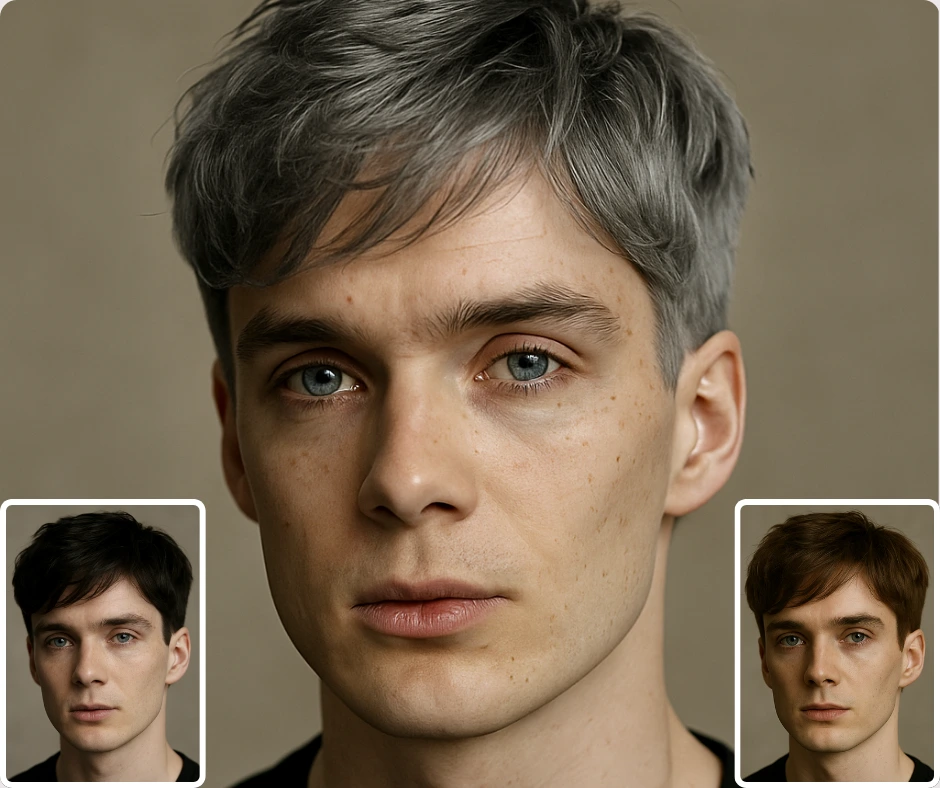
Practical benefits across industries
- Fashion & retail: preview colorways on the same model for direct product comparisons.
- Hair & beauty e-commerce: create color-swatches and product galleries showing how a dye or wig appears on different hair types.
- Salons & colorists: provide customers virtual consultations before committing to chemical processes.
- Influencers & content creators: test attention-grabbing colors for thumbnails and social posts to maximize engagement.
Quality-boosting features to watch for

- Lighting-aware color synthesis: ensures highlights and shadows match the scene.
- Strand-level texture retention: prevents the “painted-on” look common in simple overlays.
- Seed control and versioning: reproduce exact looks across multiple images or campaigns.
Additional guide: AI Hair style changer
When to choose Create Image vs. a live AR try-on
- Use Create Image when you need production-ready visuals (catalogs, hero banners, influencer stills).
- Use mobile AR tools for interactive in-browser or in-app try-on experiences where real-time head tracking is essential.
4. Step-by-Step Guide: How to Try On Virtual Hair Colors with PiktID
This step-by-step walk through shows a practical workflow to run a virtual hair color try on session using Create Image — from prompt to final asset.
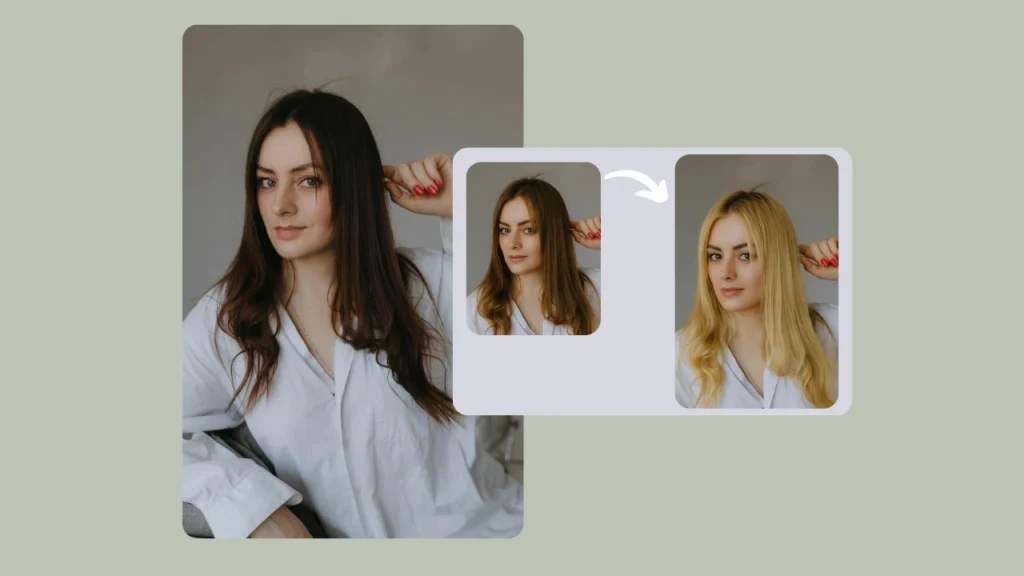
Step 1 — Write a descriptive prompt (best practices)
- Start with subject and pose: “portrait of a woman, 3/4 pose, softbox lighting.”
- Add hair specifics: length, texture, and placement: “shoulder-length wavy hair, curtain bangs.”
- Specify color details: base + accents + intensity: “ash blonde base with pastel pink balayage highlights, subtle root shadow.”
- Anchor the look with camera & quality cues: “50mm lens, shallow depth of field, photo-realistic, high detail.”
Example prompt: portrait of a young woman (3/4) with shoulder-length wavy hair, ash blonde base with pastel pink balayage highlights, natural root shadow, soft-box lighting, photo-realistic, high detail.

Step 2 — Edit model settings (pro tips)
- Conditioning: lower values keep the subject closer to the original; raise it for more dramatic color or style changes.
- Diversity/Creativity: increase to explore bold variations, reduce to keep outputs conservative and brand safe.
- Seed control: lock the seed to maintain the same pose/face across multiple colorways for consistent galleries.
- Resolution & aspect: choose output sizes for web (2048 px long edge) or print (higher DPI).
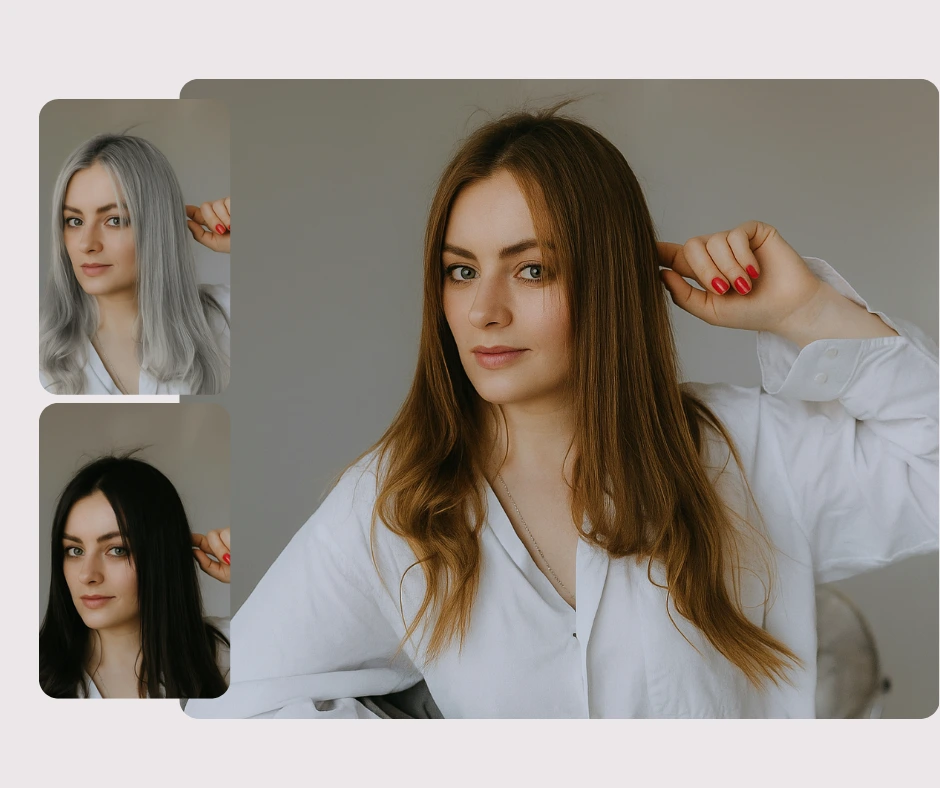
Step 3 — Generate and evaluate
- Click Generate to produce a batch of candidates.
- Use the History tab to compare versions side by side. Prioritize images that preserve hair texture and maintain consistent skin undertones.
- Download your preferred results in high resolution.
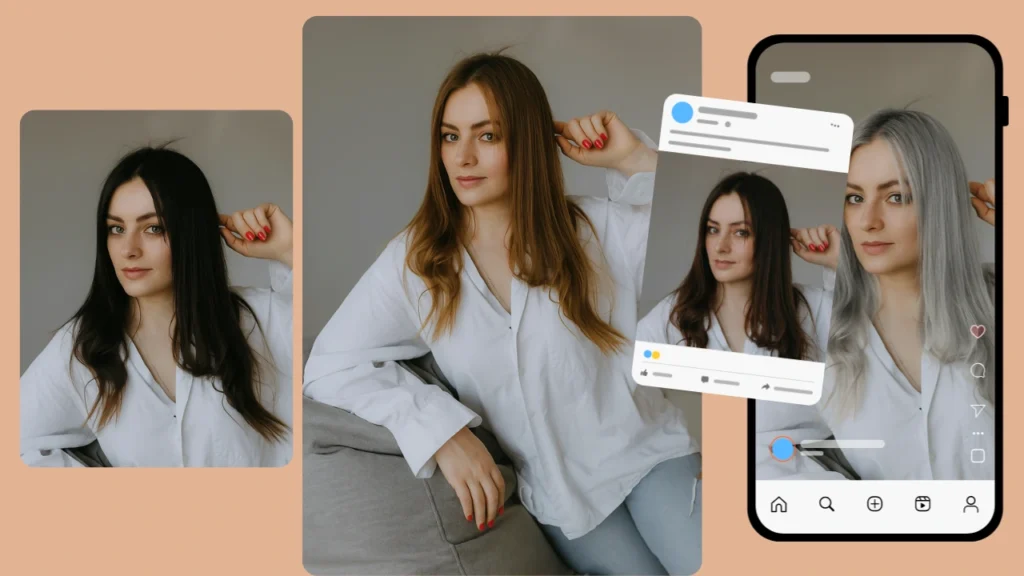
Refinement loop (iterate for polish)
- If a result looks slightly off: tweak prompt adjectives (e.g., “warmer tone,” “less saturation”), rerun with the same seed, and compare.
- Use small negative cues to reduce common artifacts (e.g., “no extra strands, avoid over smoothing”).
- For catalogs, batch-generate all colorways using the same seed and save prompt+seed metadata for reproducibility.
Troubleshooting & quick fixes
- Washed-out color: specify “vivid” or “high saturation” and add a lighting cue like “studio lighting.”
- Unnatural edges at hairline: include “natural hairline” or enable hair integration settings where available.
- Inconsistent shadows: add “natural root shadow” or “soft-box lighting” to the prompt.
Additional Guide: Refer AI Clothing Model
5. Benefits of Using Virtual Hair Color Try On
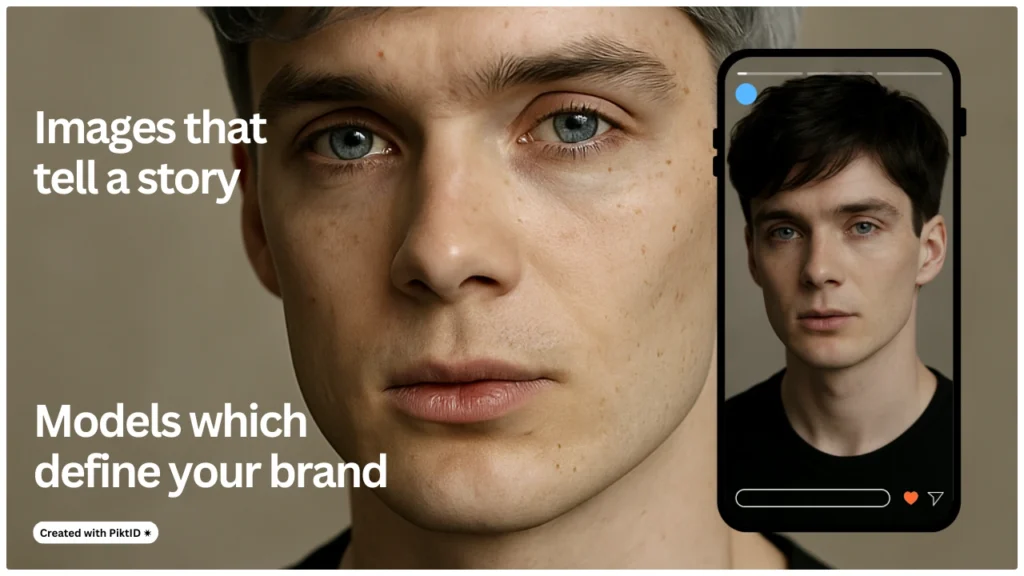
Virtual hair color tries to transform how individuals and brands experiment with hair color by removing cost, time, and commitment barriers. For consumers, the most immediate benefit is financial: you can preview multiple color options without paying for salon consultations or corrective color treatments. That reduces the risk of expensive fixes and saves money on trial and error appointments.
For personal styling and content creators, virtual hair color unlocks creative freedom. Users can test bold, seasonal, or experimental shades—neon, pastel, balayage blends—without permanent change. This encourages bolder creative choices for social media content and editorial shoots, where novelty often drives engagement.
Brands and retailers also gain distinct advantages:
- Interactive merchandising: Showcase product shades on a range of faces to help customers visualize results.
- Higher conversion: When shoppers see realistic color previews, purchase confidence improves and return rates decline.
- Faster creative cycles: Marketing teams can generate campaign variants (different hair colors, models, and lighting) without organizing multiple shoots.
- A/B testing at scale: Run colorway tests across target demographics to learn which shades convert best.
Operationally, virtual hair color supports accessibility and scale. Remote customers and international teams can preview looks without geographic constraints. For stylists, it becomes a communication tool—clients can send preferred color references and see real time previews, shortening consultation time and improving outcomes.
Overall, the capability drives better decisions for consumers and more efficient work flows for businesses, while increasing engagement for creators and brands.
Read more: AI Hairstyle changer
6. Pro Tips for Best Results
To get the most realistic outcomes from virtual hair color try on workflows, follow these practical, field-tested tips:
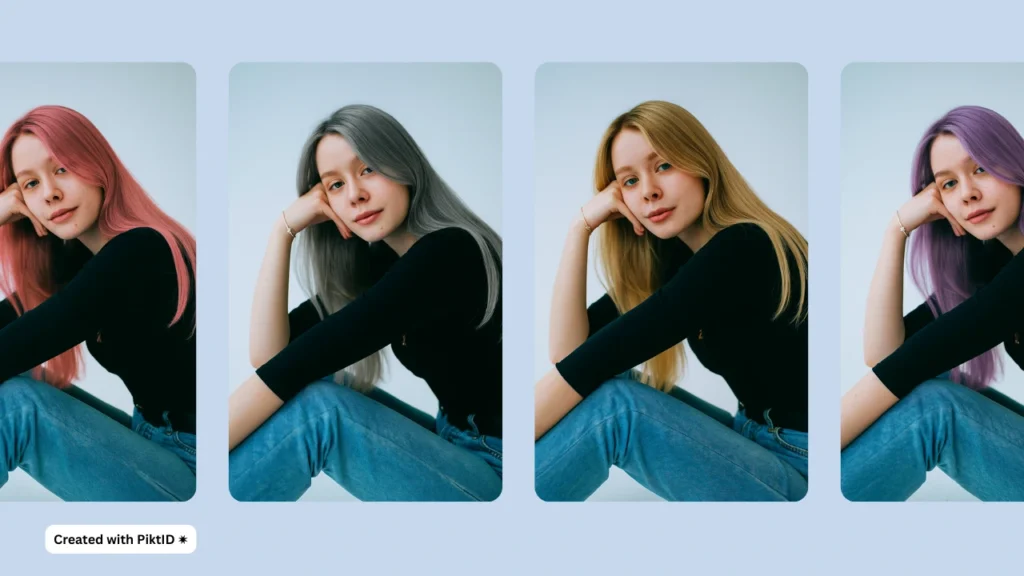
a. Image quality and capture
- Use high-resolution base images (1024×1024 or higher) to preserve hair strand detail.
- Keep lighting even and natural when capturing photos—soft daylight or controlled studio light yields the most natural color blending.
- Avoid extreme backlighting or heavy motion blur; these reduce the algorithm’s ability to reconstruct hair texture.
b. Prompting and color description
- Be descriptive with prompts. Example: “dark chocolate brown with warm caramel balayage, soft natural highlights, medium shine, studio softbox.”
- Include contextual cues: specify lighting (“golden hour backlight”), finish (“matte vs. glossy”), and parting/volume if important.
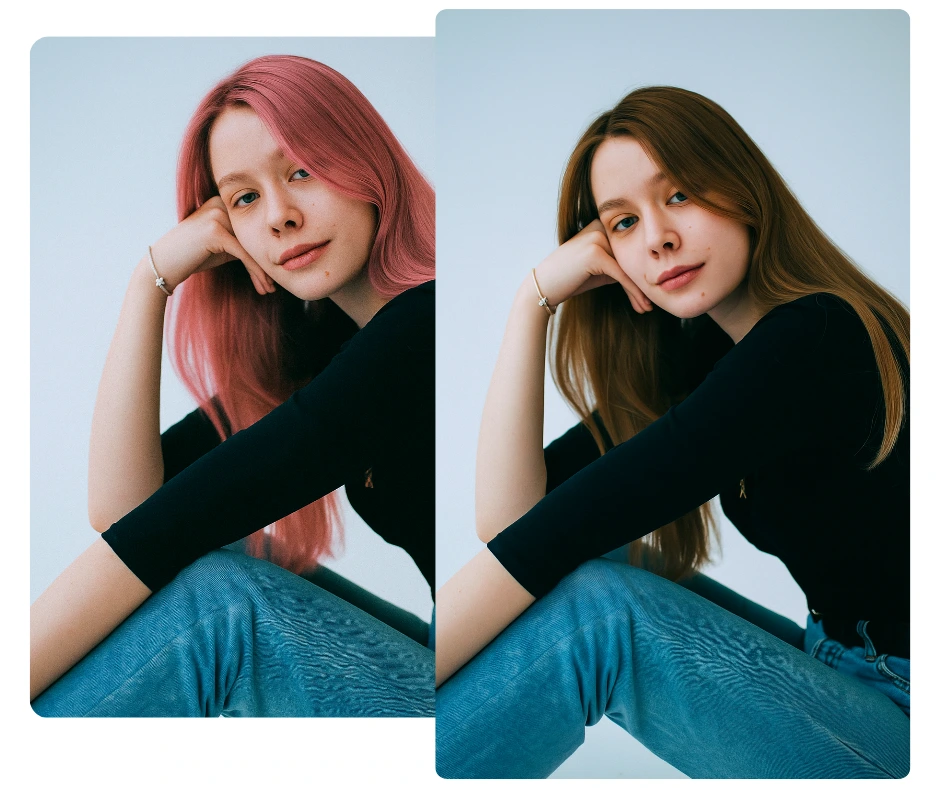
c. Masking and region control
- Mask only the hair area when possible to avoid unwanted color spill onto skin or clothing.
- Preserve catchlights and corneal highlights so the subject’s eyes remain natural—this prevents the image from appearing overly edited.
d. Iteration and settings
- Generate multiple variations and compare side by side before finalizing; small tweaks in prompt strength or conditioning produce different realism levels.
- Use advanced parameters (diversity/conditioning/seed) to control how closely the change adheres to the original or explores creative alternatives. Lock a seed to reproduce a favorite result across multiple images.
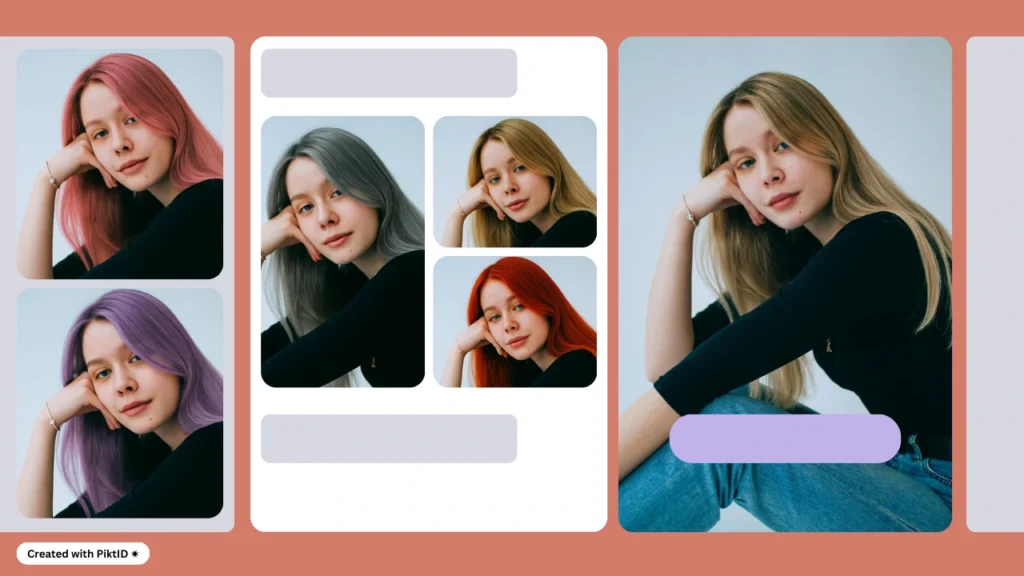
e. Final checks and delivery
- View results on multiple devices to ensure color consistency across screens.
- Upscale the chosen image for final use to retain crisp hair detail in hero placements.
- Keep a prompt and seed library for consistent campaigns and reuse across catalog images.
Following these guidelines will maximize realism and ensure your virtual hair color try on outputs are production ready.
Read more: AI Clothes Swap
7. Real-Life Use Cases
Virtual hair color try on is already delivering measurable value across individual, creator, and commercial work flows. Below are practical scenarios that show how the feature converts curiosity into decisions and content.

a. Individuals — Confident salon decisions
- Try multiple color families (blondes, brunes, pastels, vivid tones) on a single photo to see how hues interact with your skin tone and lighting.
- Reduce buyer’s remorse and avoid costly color corrections after a salon visit.
- Example outcome: preview 4 color options in 10 minutes and bring the favorite to your stylist as a reference.
b. Influencers & Content Creators — Fast trend cycles
- Produce daily or weekly posts showing different color stories without repeated salon visits.
- Experiment with latest trends (pastel fades, neon streaks) for social first content.
- Benefit: higher engagement with lower production cost and faster content cadence.
PiktID’s Change Clothes AI
c. Brands & Retailers — Product visualization and conversion
- Allow customers to virtually test dye shades or colored products on product pages to reduce returns and increase conversions.
- Use generated assets for ads, landing pages, and email campaigns showing the same model in multiple colors.
- Business impact: quicker A/B testing of color ways and improved click through on visual ads.
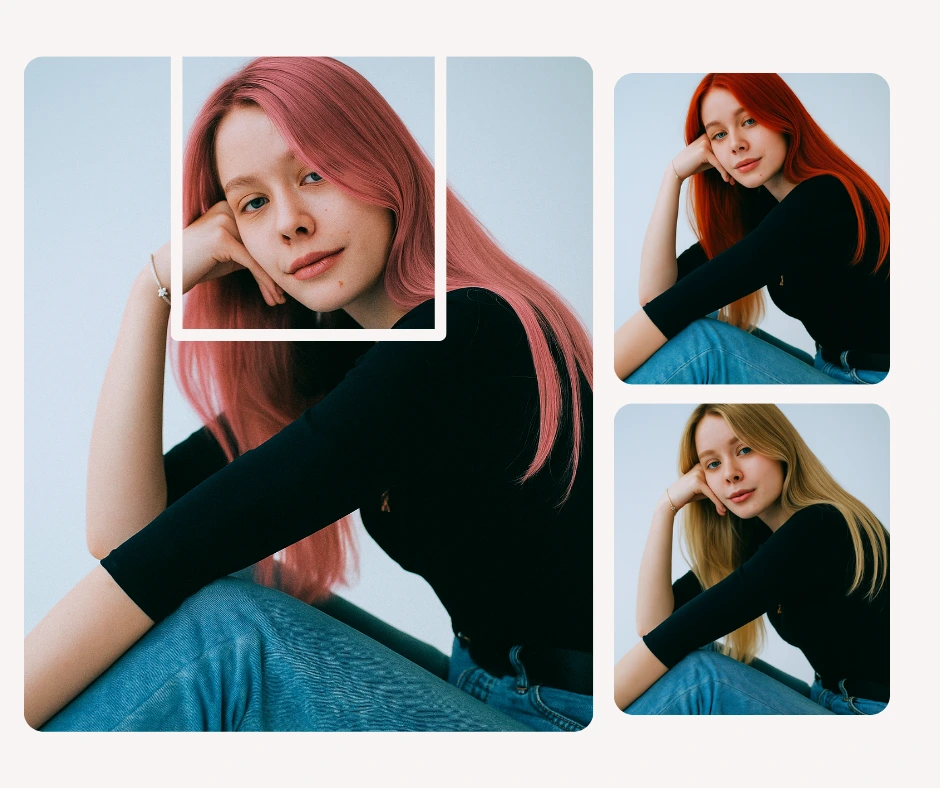
d. Salons & Stylists — Consultation & up-sell
- Use virtual previews during consultations to set realistic expectations and recommend complementary treatments (toners, glosses).
- Up sell color services with a preview-driven approach that shows precisely how a service will look.
e. E-commerce & Creative Teams — Catalog scale
- Generate campaign ready hero images that show multiple color ways without re shoots.
- Maintain consistent lighting and model identity across variations for a cohesive catalog presentation.
Try these workflows with PiktID’s Create Image tool to turn exploration into actionable visuals.
8. Getting Started with PiktID

Virtual hair color try on with PiktID’s Create Image streamlines the path from inspiration to decision. It saves time and money by replacing multiple photo shoots and salon trials with a single, iterative digital work flow. For individuals, it reduces risk and increases confidence; for creators and brands, it accelerates content production and improves conversion-ready imagery; for salons, it sharpens consultations and drives up-sells.
Key takeaways:
- Faster experimentation: test dozens of shades in minutes.
- Lower costs: fewer re shoots and reduced studio time.
- Better outcomes: realistic previews that respect lighting, skin tone, and hair texture.
Ready to find your perfect shade? Start testing with Create Image and explore virtual hair color try on today. Try it now and begin with 10 free credits.
9. FAQs
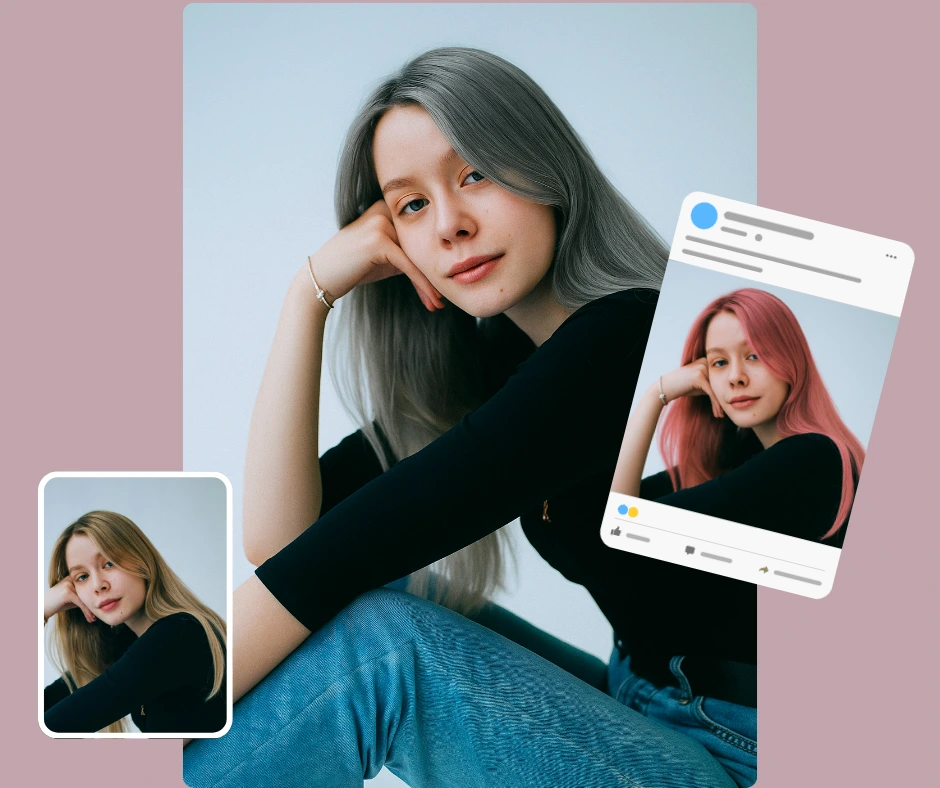
Q1: Is the virtual hair color realistic?
Yes. PiktID’s virtual hair color try-on uses lighting aware synthesis and texture preservation so color, highlights, and strand detail look natural. Results account for existing highlights, skin tone, and scene lighting to avoid flat, “painted on” colors. For best fidelity, upload a high resolution, evenly lit photo.
Q2: Can I try highlights and balayage styles too?
Absolutely. You can request specific techniques—highlights, balayage, ombré, root shadow, or full color treatments—and combine them with color families (e.g., caramel balayage, ash blonde highlights). Use descriptive prompts (placement, intensity, and finish) to guide the model toward subtle or dramatic looks.
Q3: Do I need professional editing skills to use it?
No. The interface is beginner friendly: enter a prompt, adjust optional advanced settings, and generate. Professionals can use advanced parameters (conditioning, diversity, seed control) and masking tools to fine tune results for commercial shoots.
Q4: Can brands use this for e commerce product images?
Yes. Retailers and beauty brands use PiktID to create product swatches, campaign assets, and colorway galleries without re shoots.
Best practices: batch generate variants with locked seeds for consistency, then quality-check hairline blends and shadow continuity before publishing.
Q5: Does it work only on human photos?
No. You can apply color to uploaded photos or generate fresh AI models with specific hair colors and styles using the Create Image or Generate Person work flows. This makes it easy to produce look books, ads, and localized catalog images at scale.

